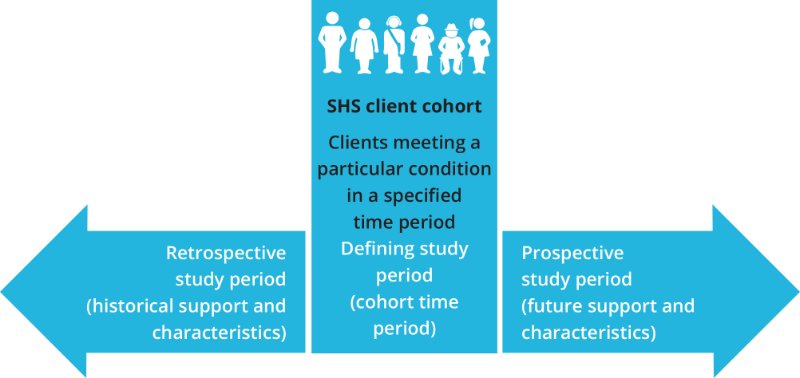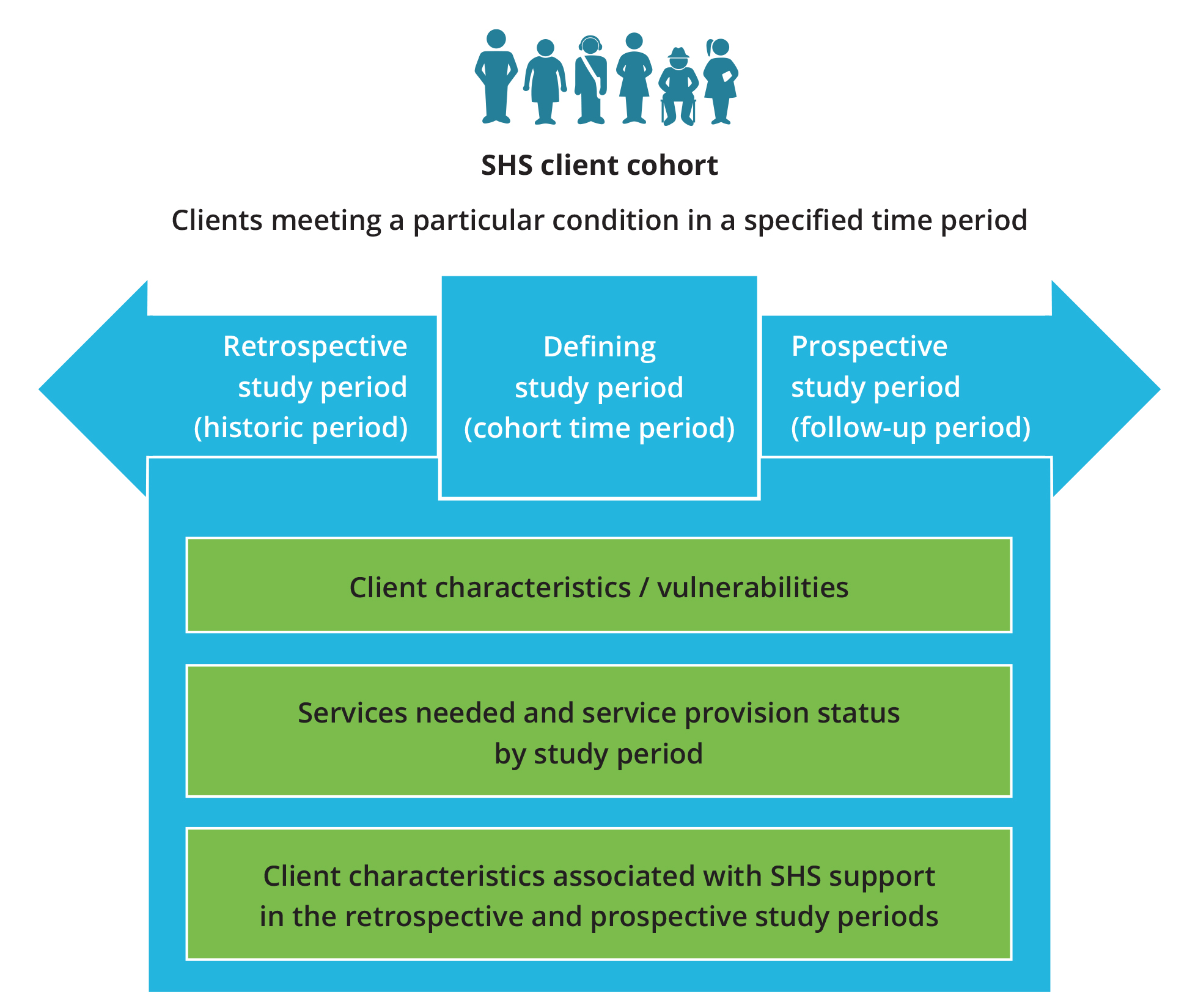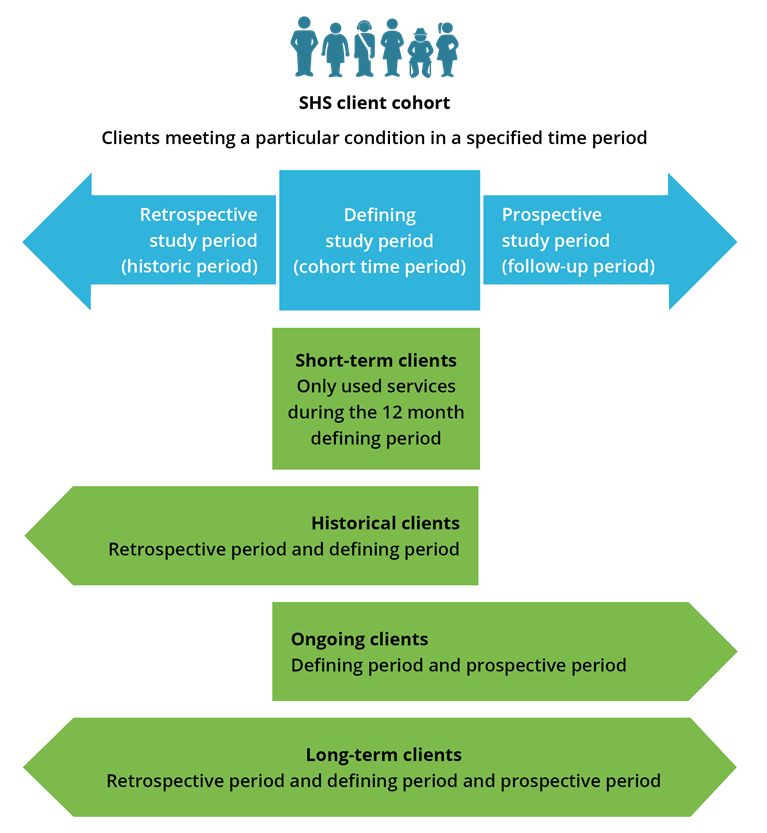Introduction to the SHS longitudinal data
The Specialist Homelessness Services (SHS) Collection (SHSC) commenced on 1 July 2011. Data are provided by over 1,700 government-funded agencies that deliver homelessness services to people in need of support. These data are based on interactions between clients and service providers and are collected at fixed points in time:
- at the start of a support period
- at the end of every month during a support period
- at the end of a support period.
SHS Agencies provide these data to the AIHW on a monthly basis. For detailed information about the SHSC see Specialist Homelessness Services Collection.
More information about the SHS data
The following resources provide important details of the AIHW SHSC that assist in interpreting the longitudinal analyses of the data:
SHS National Minimum Data Set – describes the collection and usage attributes of the data, including definitions of the variables collected.
SHS data quality statements – published annually and provide key insights into the coverage, relevance and accuracy of the data.
SHS Collection Manual (PDF 2.6 MB) – provides a ‘user friendly’ guide to collecting data for agency workers including how the questions are structured.
SHS annual report – summary report on clients and services provided within a financial year. These reports provide useful information on the characteristics of clients and of their service use, including for key client groups and are accompanied by interactive data cubes.
SHS monthly data – high level summary data released quarterly on the number of clients receiving support each month.
In addition to this, the SHSC data have potential to support longitudinal analyses. Specifically, the types of support provided to clients over time can be examined and can provide valuable insights into the experiences of SHS clients over time and as well as important evidence for future policy development.
The AIHW has explored this previously in reports that examined patterns of service usage across multiple years, for example:
- Couch surfers: a profile of Specialist Homelessness Services clients (1 July 2011 to 30 June 2015).
- Sleeping rough: a profile of Specialist Homelessness Services clients (1 July 2011 to 30 June 2015).
- People in short-term or emergency accommodation: a profile of Specialist Homelessness Services clients (1 July 2011 to 30 June 2015).
- Older Clients of Specialist Homelessness Services (1 July 2013 to 30 June 18).
SHS clients can be either experiencing homelessness or at risk of homelessness
When interpreting SHSC results, it is important to note that not all clients in the data are homeless. Many are ‘at risk’ of homelessness and some of these never experience formal homelessness. For example, more than half (56%) of clients with closed support started their first support period of 2020–21 at risk of homelessness and 67% finished their last support period of 2020–21 at risk of homelessness (AIHW 2021).
Longitudinal analyses
The analyses of SHSC data presented here are based on longitudinal data constructed from support-period level data from 2011–12 onwards. Analyses of these data examine aggregate client characteristics within 3 study periods (see Box Intro.1). These study periods facilitate the analysis of client characteristics within a set cohort period (defining study period), over periods of past SHS support (the retrospective study period) and their future SHS experiences (the prospective study period).
The SHS longitudinal data contain information for over 1 million individual clients nationally since 1 July 2011. The data offer a unique opportunity to quantitatively explore, and in some cases, validate or replicate, the myriad qualitative studies on homelessness that, while rich in depth (being based on interviews, questionnaires, or case notes), are often based on relatively small sample sizes.
Longitudinal analyses of SHSC data cannot answer all questions about people experiencing insecure housing. The analyses presented here make the most of the available data by providing unique insights into the support profile of SHS clients over long periods of time. They also highlight areas that may warrant further and more detailed investigation through further research or other analyses of data.
Box Intro.1: SHS longitudinal analyses - Study period approach
The SHSC longitudinal data are analysed by partitioning a client’s time receiving SHS support into 3 periods (also Figure Intro.1):
Defining study period
This is the key period for which client characteristics and experiences are aggregated. It can vary in length for each analysis but is typically 12 months, to include an adequate sample of clients and to cover a long enough period to capture client outcomes. All clients will have at least one support period in this period, because the cohort is defined by clients who met a certain set of conditions within that time.
For example, a defining study period may be limited to women with a family or domestic violence experience/service needs within the period of 2015–16. Characteristics of these clients and their service use patterns would be aggregated within the 12-month defining study period. The 12-month period is different for each client, beginning on their first day of support that meets that inclusion criteria – in this case, being an FDV client and support starting in 2015–16.
Most analyses will also look at the patterns of service use before (retrospective period) and after (prospective period) the defining study period.
Retrospective study period
This period examines data for clients that needed SHS support before the defining study period. Analyses in the retrospective period examine whether a client experienced particular circumstances (for example, homelessness, unemployment, used a particular service type) in the past. A client’s presence in the retrospective period is itself a characteristic that can be studied. For example, clients that are not in the retrospective period may be considered ‘new’ to SHS services in the defining study period.
Prospective study period
This period examines data and outcomes for the clients that continue receiving support into the future. The most basic outcome is whether a client needed SHS support in this period – that is, whether they can be considered as an ongoing or long-term user of SHS (continuous or otherwise), compared with clients whose SHS engagement finished during the defining study period. More detailed analyses examine whether specific events occurred during the prospective study period, such as whether the client was homeless or what services the client used.
Figure Intro.1: Study period approach to longitudinal analyses

Some client characteristics or circumstances are associated with the use of SHS services in the past or future, relative to the defining study period. For example, clients with mental health issues in the defining study period may be more likely to have both a history of service use (in the retrospective period) and a need for ongoing service use (in the prospective period).
However, variations in state-territory specific policies and service delivery models mean that the likelihood of a client using particular services may vary between states-territories. Therefore, to assess the factors associate with past and future SHS support separate Modified Poisson Regression models were created for each state. These models are descriptive. That is, they are intended to describe which client variables are associated with past or future service use without proposing or testing specific causal pathways.
In these models, the outcome variable (receipt of SHS support) was a binary measure (yes or no) and did not distinguish between clients that needed SHS support only once in the retrospective or prospective study period and those that required frequent support. Risk ratios were created to measure the association between the use of SHS support and a set of client characteristics (see Glossary entry on Relative Risk for how to interpret the results).
These associations are presented as relative risks, which are the probability of an event occurring in one group – typically one that has been 'exposed' to a condition – versus the probability of the event occurring in a non-exposed group. It is a ratio of the absolute risk (probability of an event occurring) between the two groups and is usually reported either as ratio of risk (for example, the risk of using SHS in the future is 1.25 times for Indigenous clients versus non-Indigenous clients) or a percentage (for example, Indigenous clients have a 25% increased risk of using SHS services in the future).
Given the connotations associated with the word 'risk', which is more commonly used among studies where the outcome is an adverse event, the results of the descriptive modelling are not described as 'risk' but as the change in relative likelihood (probability) (for example, Indigenous clients are 25% more likely to continue to use SHS services). A value of 1.00 indicates no difference between the two groups; values greater than 1.00 indicate an increasing 'risk' or likelihood for the 'exposed' group and a value less than 1.00 indicates decreased risk (Andrade 2015).
Ninety-five percent (95%) confidence intervals are also presented to indicate the statistical precision and significance. The result is interpreted as having a statistically significant impact (that is, not due to chance) if the interval does not cross the value of 1.
Client characteristics/vulnerabilities
Details of SHS clients who meet the criteria for inclusion within the priority cohort are extracted from the complete longitudinal dataset (2011–12 to the latest data available) (Figure Intro.2). The data for these clients are then partitioned into 3 study periods (see Box Intro.1, Figure Intro.1).
Within each of these 3 study periods (retrospective, defining, prospective) a client can have any number of support periods. Within each support period, client circumstances are recorded as they were at 3 times – the week before support commenced, at the start of support ('at presentation') and when support ended. A subset of information is also recorded within each month of the support period, which includes services and assistance provided during the month and the client’s situation on the last day they received a service in the month.
For longitudinal analysis, most client characteristics were measured by examining whether a particular event or situation occurred at any of the 3 times for any of the support periods that occurred within each study period. For example, the housing situation characteristic within the defining period captures whether the client was homeless at any of the 3 times during any support period in the defining study period.
Client characteristics such as Indigenous status and whether a person was born overseas are derived using data from all support periods in the longitudinal data. If a client was ever recorded as being Indigenous or born overseas, they will be considered as such, even if in some support periods the data are missing or different. Although it is recognised that this method may lead to an overestimation of Indigenous clients, this method was used because identification barriers and sensitivities are more likely to lead to a reduced propensity to identify as Indigenous in administrative data collections (ABS 2012).
The client’s state or territory, age and sex are all recorded as at the start of the first support period in the defining period and used subsequently across all study periods. Other SHSC products may use a different approach.
Vulnerabilities including mental health issues, drug and/or alcohol problems, and experience of family and domestic violence (FDV) issues are assessed within each study period using the same criteria as detailed in the Specialist homelessness services annual report.
Longitudinal variable derivations are explained in more detail in the Methodology section.
Figure Intro.2: Longitudinal analysis overview

A client’s SHS support over time can also be examined by combining information from the discrete study periods into four service engagement profile groups (Figure Intro.3):
- Short-term clients, who only received SHS support during the defining study period.
- Historical clients, who received SHS support in the retrospective period and the defining study period only.
- Ongoing clients, who received SHS support in the prospective period and the defining study period only.
- Long-term clients, who received SHS support in all 3 study periods.
The challenge with this approach is that it is not clear whether ongoing clients will become long terms clients as time progresses which means detailed analyses using this classification of clients is less robust than other approaches. Therefore, this type of approach is only used when commenting on a client’s characteristics and use of SHS support over a set period.
Figure Intro.3: Service engagement profile groups

Services and assistance needed and service provision status
The SHSC collects information on the needs of clients during a support period. Information about what services were needed and whether they were provided or referred is collected at the beginning of a support period. Some information is updated at the end of each month that a client is supported and again at the end of each support period. For longitudinal analyses, a client’s need for a service is recorded if the client needed that service at any time in each study period (retrospective, defining or prospective). The need is recorded only once in each study period regardless of the number of support periods or months over which the need was recorded or the number of times it is required within each study period. The aggregation of these data means that throughout each study period, the intensity of support is not assessed. Clients requiring or receiving a lot of support in each study period are not distinguished from clients requiring or receiving minimal support.
Where agencies are unable to provide services directly to clients or unable to fully meet the need, they often refer the client to other organisations (either other specialist homelessness agencies or organisations in other sectors) that can provide those services.
All information on services provided to clients are recorded in the same way as service needs. That is, a service is recorded as provided or referred if the client was provided or referred that type of service/assistance at any time within the study period. In each case, a service is flagged as provided or referred only once in each study period, regardless of how many times the client needed that service. A client was that provided (or referred) in only a portion of the instances in which that service was required will still be flagged as having received that service.
The individual instances of a need being unmet is not assessed in these longitudinal analyses.
ABS (Australian Bureau of Statistics) (2012) Information paper: Perspectives on Aboriginal and Torres Strait Islander identification in selected data collection contexts, Australian Bureau of Statistics: Canberra.
AIHW (Australian Institute of Health and Welfare) (2015) Data linkage protocols using a statistical linkage key. AIHW Cat. no. CSI 1. Canberra: Australian Institute of Health and Welfare.
Andrade C. (2015) ‘Understanding relative risk, odds ratio, and related terms: as simple as it can get’. Clinical and Practical Psychopharmacology, vol. 76, issue 7, pp 857-861.


